Project Description
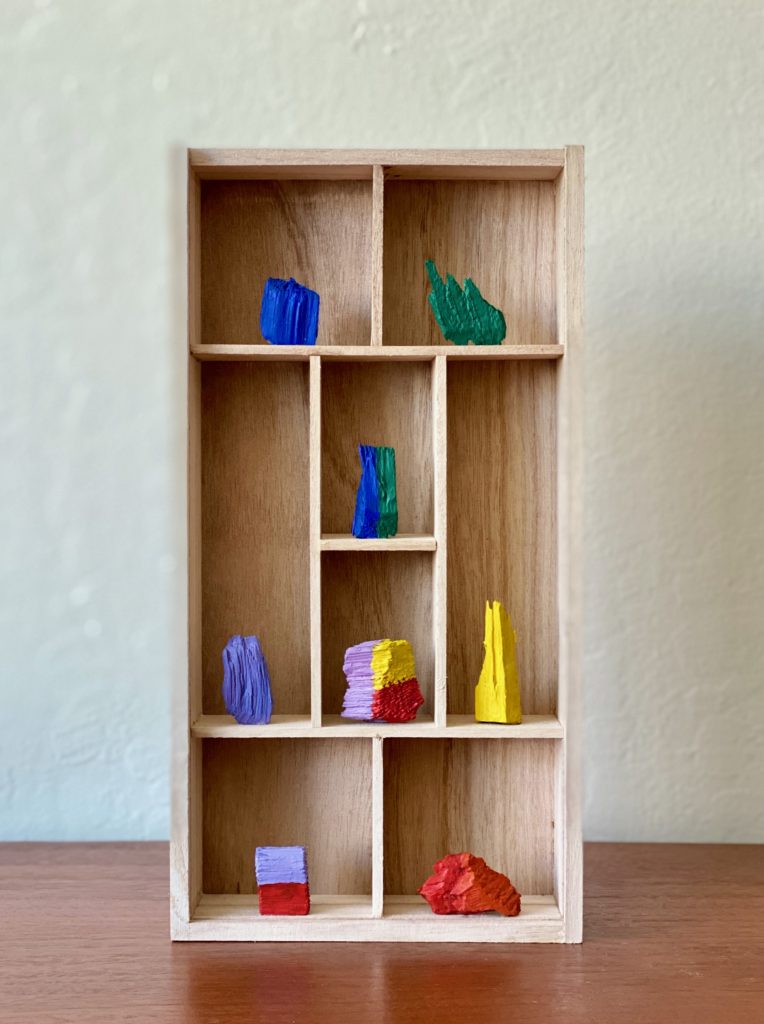
Possibilities
Possibilities is a series of works realized during the first Covid lockdown in San Francisco in March 2020. Each “Possibility” represents the discomfort and the potential held within the spatial confinement, along with the meanings emerged from moments of solitude, of hope, of solidarity, and of disorientation lived inside that atypical confined space. Possibilities gathers the voices of my community, re-framing the individual’s condition within a choral dimension. This series was conceived in parallel with the Manifesto of Uncertainty that I wrote for the art project Art Seeds in April 2020.
Possibility n’1, I am Waiting
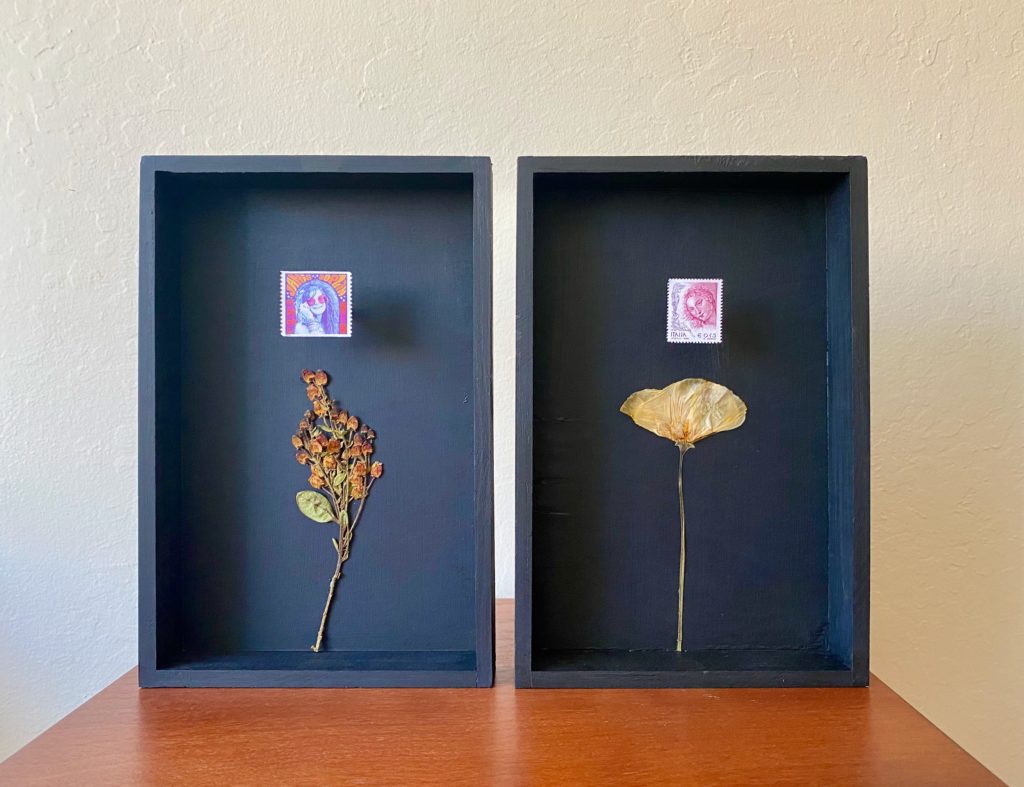
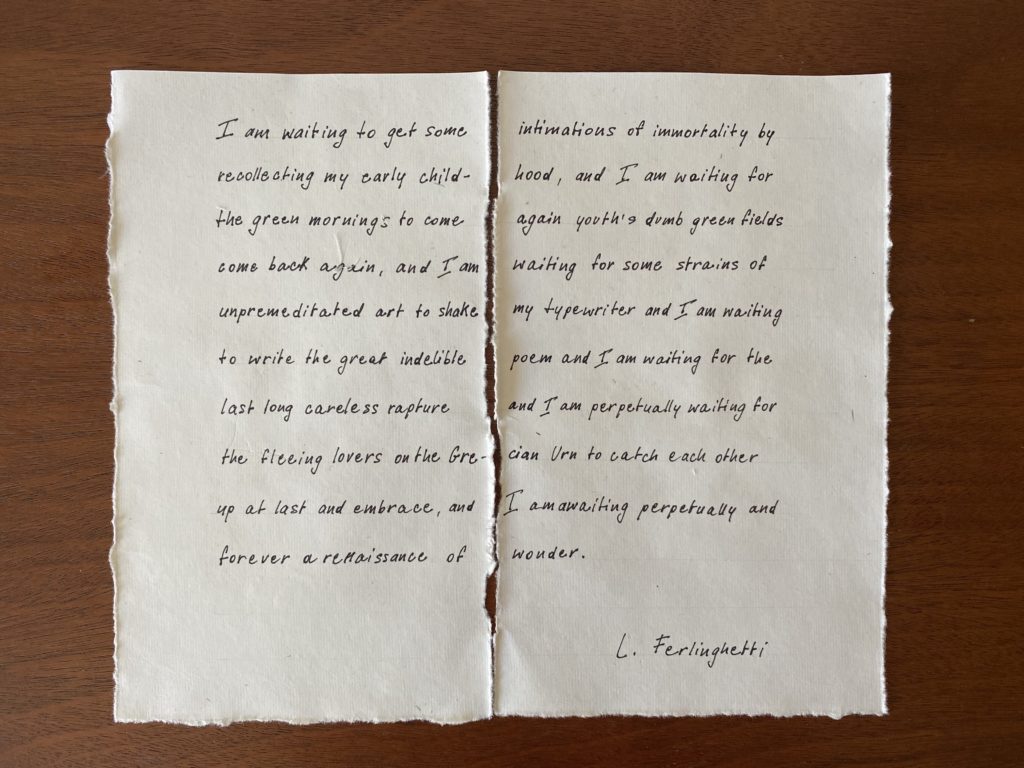
I handwrote an excerpt of “I am waiting”, the 1958’s poem by Lawrence Ferlinghetti, on a paper teared in half and then displayed as rejoined along the edges of the thin fracture. Beside the poem there are two shadow boxes representing San Francisco, or California in a broader sense, and Italy. The references to the two countries, that are 10.047km distant between each other, are symbolized by the stamps —remote communication tools that preserve, reinterpret, and divulge national histories through an iconographically and stylistically peculiar language.
The stamp of Janis Joplin (musical icon of the 60es who contributed to define the cultural and artistic heritage of San Francisco) was released in 2014 as part of the limited series Music Icons Forever Stamp. Janis Joplin’s stamp replicates Antonio Alacalà’s design from 1970, inspired by a photograph of Joplin taken in New York by David Gahr. The stamp was launched at Outside Lands Festival. Outside Lands is the largest independent festival of the United States and it was founded in 2008. In 2019 it got the license to sell marihuana, and it also includes a Visual Art section. The independent, eco-friendly, gay-friendly and multi-artistic identity of the festival is 100% in line with the typical cultural background of San Francisco, which Joplin was an essential part of in 1963. The Italian stamp portrays a detail of Titian’s painting “Venere d’Urbino” (1538), displayed at the Uffizzi Galleries in Florence. This stamp was released in 2004 as part of the 1998’s Women in Art limited series. The series was realized by incisor Rita Morena and it celebrates the female icons of Italian art history (the series also recalls works by Raffaello and Piero della Francesca). Venus’ face is framed by the stylized images of the Mediterranean symbols such as the ear of wheat, the olive branch and the vine branch. The word “Italia” in lapidary type replicates the “Iscrizione di Ferentino”, a bronze roman board from 101 A.C. found on Colle del Quirinale, near Rome, today displayed at the Archeological Museum of Florence.
The Californian and Italian shadow boxes respectively contain the dried flowers of corbezzolo and of the poppy. The corbezzolo is the national flower of Italy, while the poppy is the national flower of California. The exchanged location of the flowers into the cases refers to my sense of belonging to both countries. I have imported in San Francisco my Italian origins, but I’ve started to cultivate the fruit of the Californian experience in Italy. Many immigrants share with me the “experience of loss”, or we could also say of the transformation of the original cultural aspects into contaminated qualities. People experiencing my situation will never be able to fully integrate in the new chosen country, nor will they ever find their place into the homogenous choir of the mother country again. Once you have left home, you won’t be able to go back as the same person you were when you departed. This doesn’t mean to abandon, it rather means to evolve.
I am Waiting is dedicated to all the expats around the world that assisted to the closure of the borders of the “new” and of the “old” country and to the suspension of flights, therefore finding themselves to must accept a double grief, unwillingly and abruptly. The correspondence with the mother country is suspended, but the dialogue will always be open within our hearts.
Possibility n’2, Complementary Colors

The colors that are diametrically opposite inside the color wheel are called “complementary”. The presence of a color in the spectrum assumes the existence of the nearby and opposite color. No color can exist independently within the color wheel.
Complementary Colors represents the necessity for any person to maintain social contacts during the shelter-in-place and, generally speaking, during any stressful moment. Visualizing the relationships that we have cultivated during our lifetime, and that we have believed in, can comfort us to cope with the desolating landscape the health emergency exiled us in. In the “Manifesto of Uncertainty” I name some values that can build the post-Covid new renaissance, and that will help us to pass through the limb of uncertainties and anxieties with a constructive approach. These values are: empathy, human relationships, and creativity.
Complementary Colors foster these values highlighting the importance of social network for individual serenity. This work is dedicated to all the people that have been close to me during this odd time, and that have kept being present in my memory and with their voices; it is also dedicated to all the people I encountered since March 15th (the last day before the lockdown): the passer-by I shared the sidewalk with, the mailman who delivered a letter, the grocery shop’s cashier, the artists with whom I spoke and collaborated via phone or email, the doctor who assisted me online.
Possibility n’3, Adapting
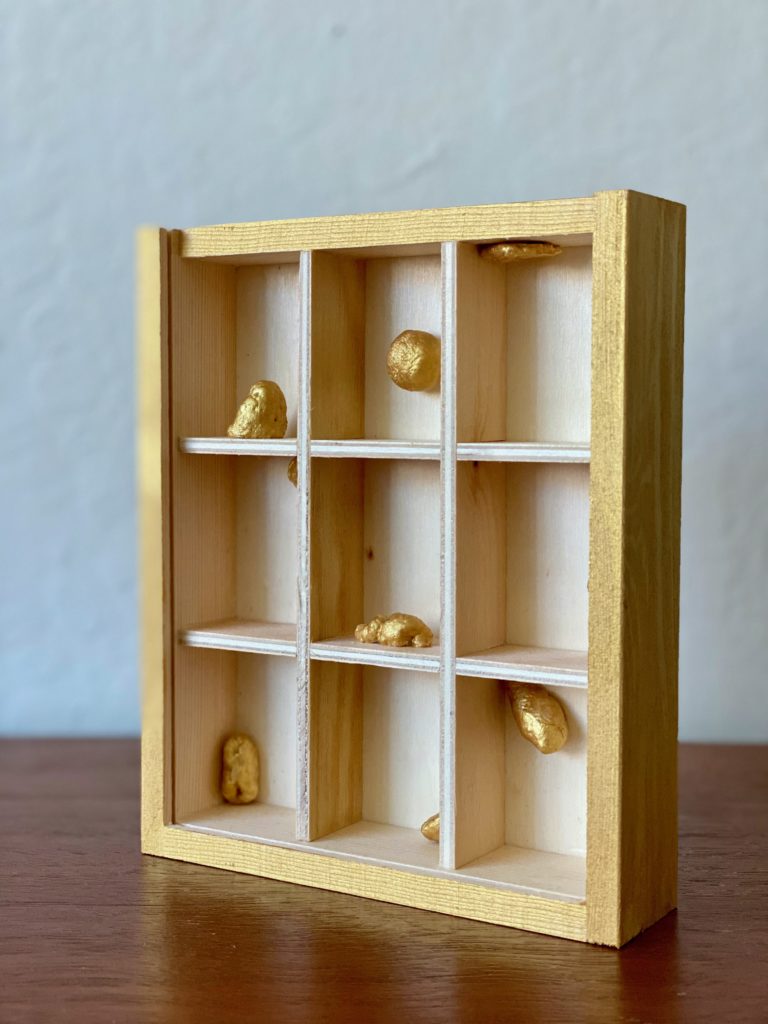
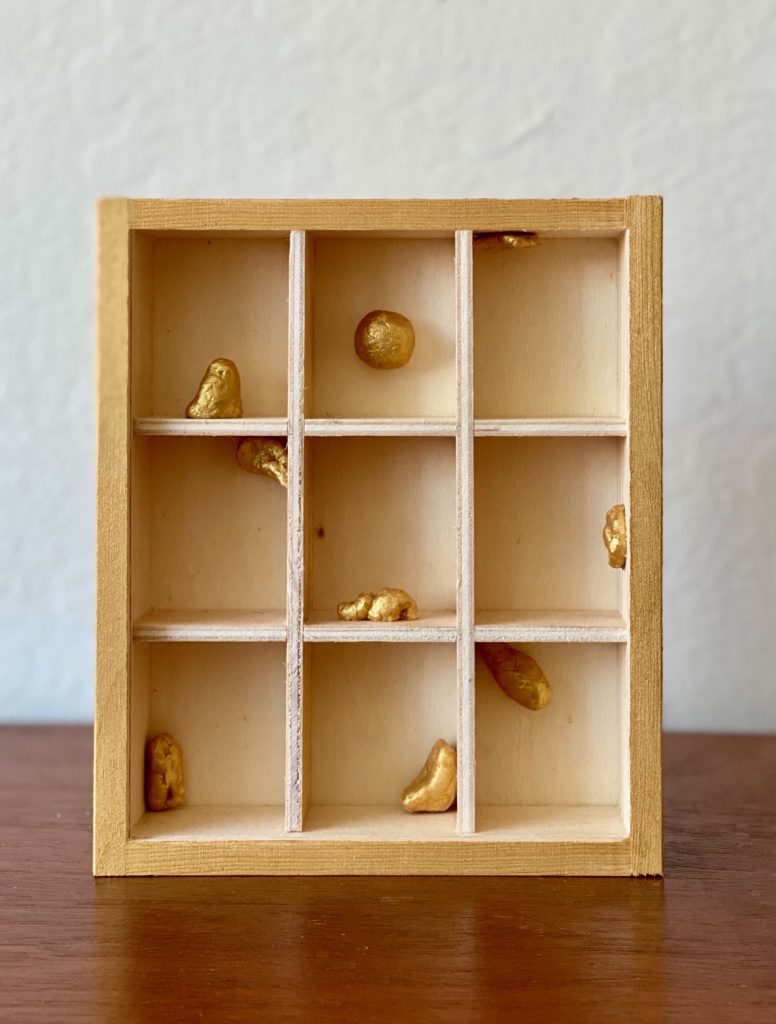
Adapting: to represent the limited freedom of movement as a game. The shapes in the grid are painted of the same gold-color of the outer case —inside and outside are connected, even though only symbolically. This work is dedicated to all the people that are experiencing/have experienced the long shelter-in-place, proving their ability to adapt and reinvent themselves within a narrow space and a dilated time dimension.
Possibility n’4, Tuesday, April 7th 2020
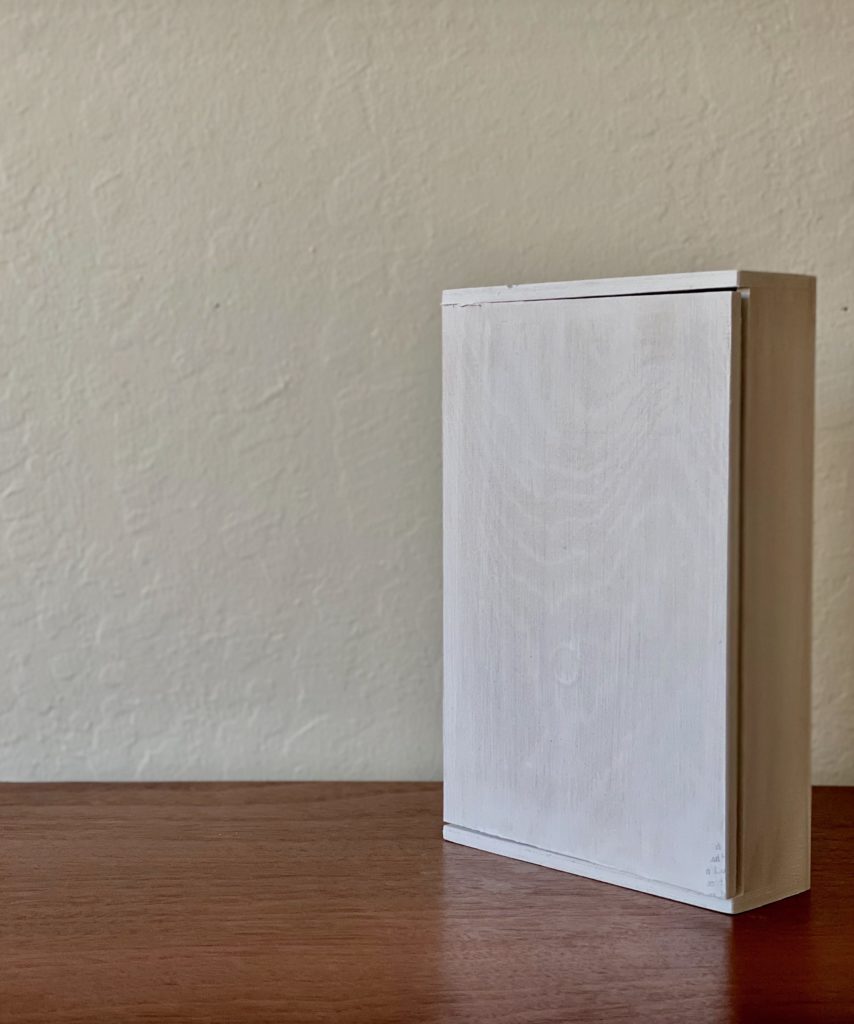
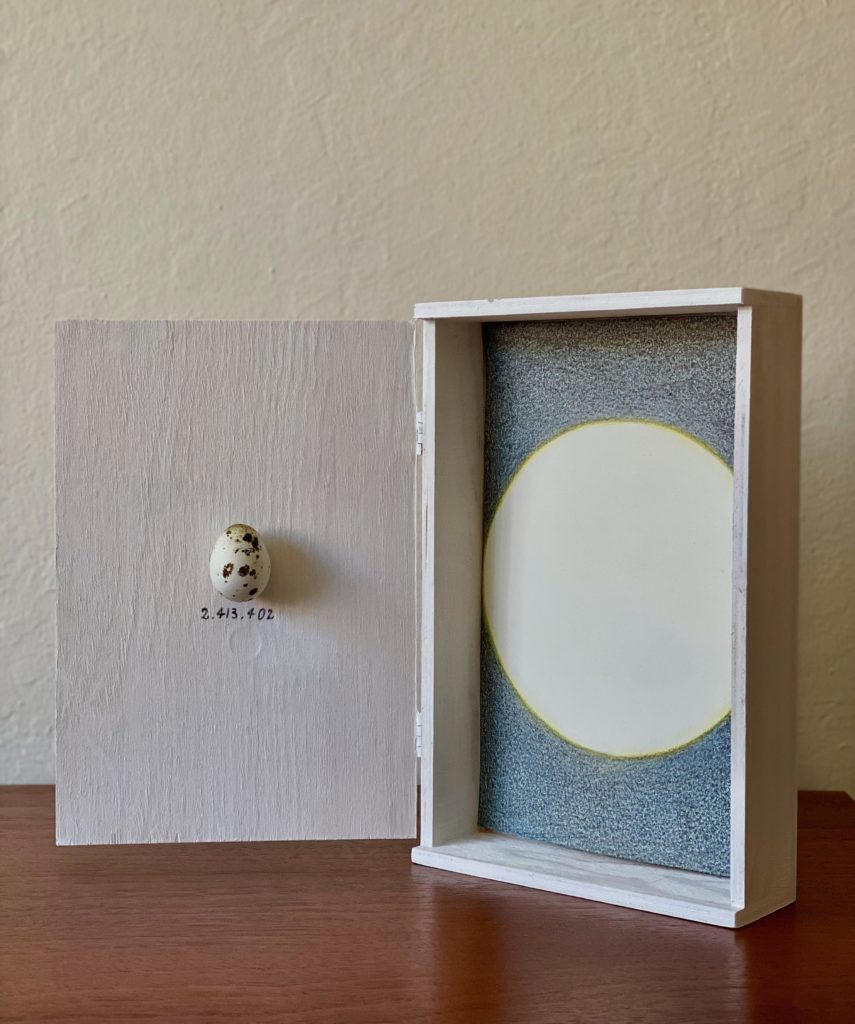
On the night of April 7th, the Moon was 27.092 km closer to our planet. Usually the Moon orbits at 384.000 km of distance from the Earth’s center, but on that Tuesday night the distance between the satellite and the Earth was only 356.908km. Because of this, the Moon looked 7% bigger than usual and 15% brighter. Tuesday April 7th records “the Natural event of the year”: the Super Moon —event that happened during a global crisis that stopped the world.
The Moon and the egg represent fertility and purity, they are suggestive elements with an ancient and universal symbology; the first one belongs to the cosmos, the latter to the Earth. The Moon comforted our ancestors through its light and its alluring charm, it inspired poets, cult ministers, nymphs, astronomers. The Moon is highly celebrated by the ancient mythology that commemorates this special planet as an influential entity bringing fertility and rebirth, and regulating the cyclical natural-human life stages. The egg is a fascinating object for its form and function, and its symbology dates back to the votive cultures of the Neolithic Age. The Egyptians compared it to the phoenix as an expression of rebirth from aches; in alchemy it is a talisman able to lead back any element to their original pure status, while in Hinduism the egg’s image is linked to the one of the Primordial Egg that generated the earth and the universe. The pagan symbology of this elegant object, bearer of life and resurrection, has been assimilated and reinterpreted from Christian religion and from Art History during the time.
Using both the egg’s and the Moon’s images, this work evokes the opposite and simultaneous realities of the dynamic celestial life that continues its course and of the human life on earth, currently static and confined in delimited spaces, and suspended in the dilated time of waiting. The length of the moon orbit, written beneath the egg: 2.413.402 km lead back the liminal earthly dimension to “normality” —while human life has slow down in a way that we almost perceived it as being stopped, planets keep moving. Tuesday April 7th represents the possibility for these two realties to meet —they are physically far, but deep inside still connected to each other.
Possibility n’5, 24 Hours
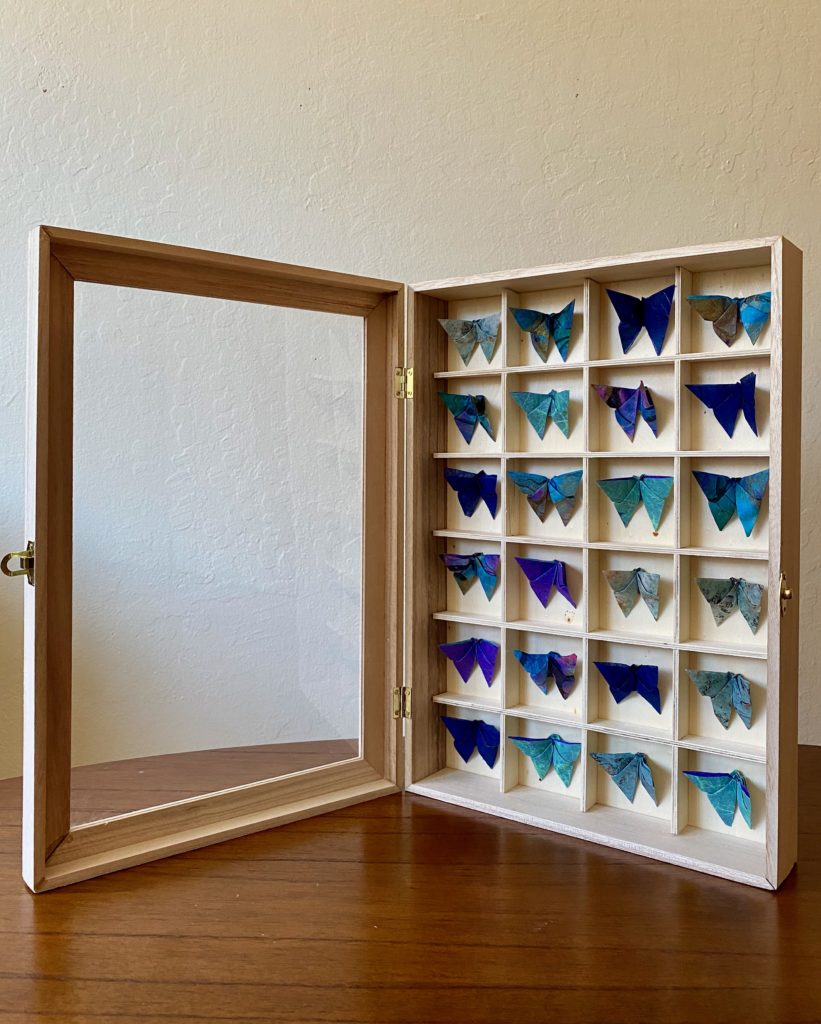
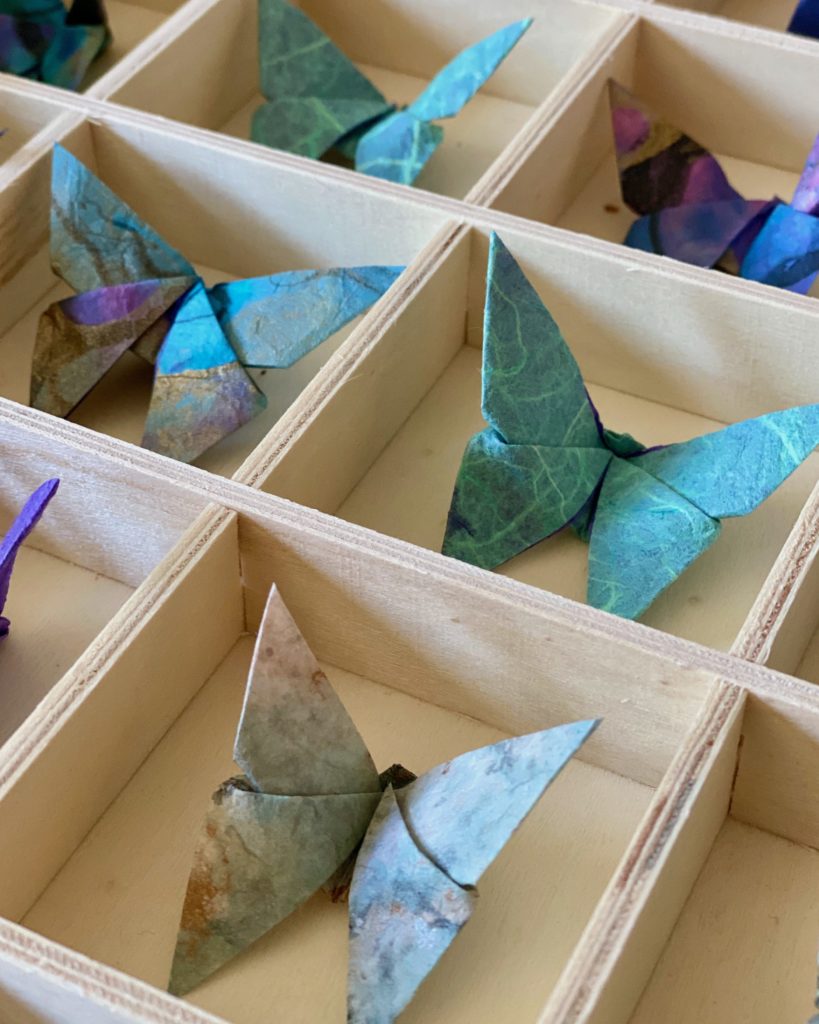
“Every twilight is double, aurora and evening. This formidable chrysalis which is called the universe shivers eternally in feeling, at the same time, the agonizing caterpillar and the butterfly reawakening ”, Victor Hugo.
The butterfly belongs to the lepidoptera invertebrates species; its life cycle consists of four phases: egg, caterpillar, chrysalis and adult. What men call “butterfly”, cherishing its colors and lightness and dedicating it poetic verses, is the organism that develops in the last phase. Within the common and literary language, the butterfly has become a metaphor of pure and fleeting beauty, of vanishing joy, and of innocent love. Such a small insect can embody indomitable feelings like melancholy and passion, and universal meanings like rebirth and transformation. Therefore, the butterfly possesses a powerful symbology. Power can be seen as strength, a quality underestimated when praising the butterfly’s beauty. The concept of strength can be variously interpreted —is the physical or moral strength more remarkable? Why do we call a man “strong”, and why do we call so a woman? Do we need more strength to lift 140kg, like the Olympic champion Paul Edward Anderson did, or do we need more strength to work in an hospital during the Covid-19 pandemic, in 12 hours shifts and no possibility to drink or eat, like nurse Melanie Arciega did at the Seattle Medical Center? The global crisis related to the pandemic lead us to reconsider the concept of strength —being strong can mean to be able to resist to fear, to keep fighting for life, to keep believing in humanity. Being strong means being able to bend into the confined space of our house and into the limited social freedoms without braking. Strength is Resilience.
The life cycle of some species of butterflies is shorter than 24 hours: 24 hours to explore a small corner of the world, to coupling, and to nourish themselves enough to accomplish the last imminent wings flap. Strength can also mean being able of channeling our life expectations within the brief time-lapse of one single day. Because the uncertain historical moment requires to re-address our life choices to the immediate present we need to look at the next 24 hours as “our world”, just like butterflies do. As the philosopher Rabindranath Tangore wrote: “The butterfly doesn’t count the years, but the instants: for this reason its time is enough for her”. We can’t go back in time and our own projection in the future is blurry, but the present moment is still a valid possibility for experiencing will and growth.
This artwork commemorates the human soul’s intrinsic strength existing regardless of sex, age, body size and physical health, applied to the daily dimension. Getting inspiration from the life cycle of butterflies and from their powerful symbology, 24 hours represents the immediate present not only as a circumstance of mere existence, but as a possibility for self-realization.
Possibility n’6, Carpe Diem
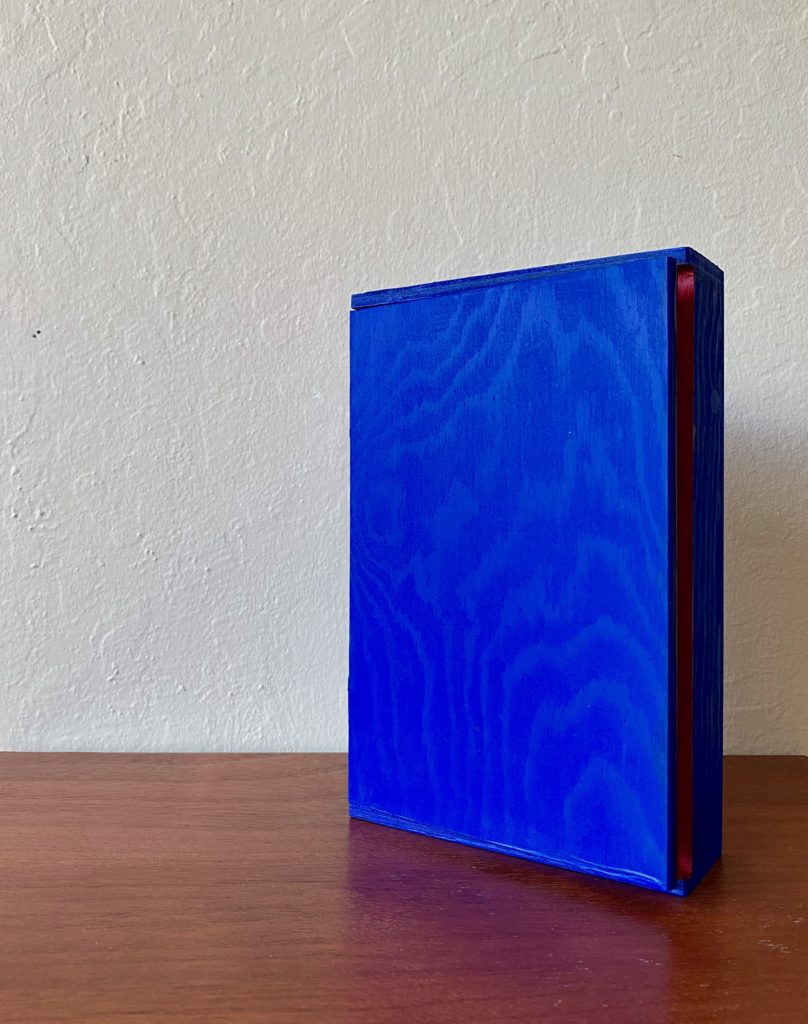
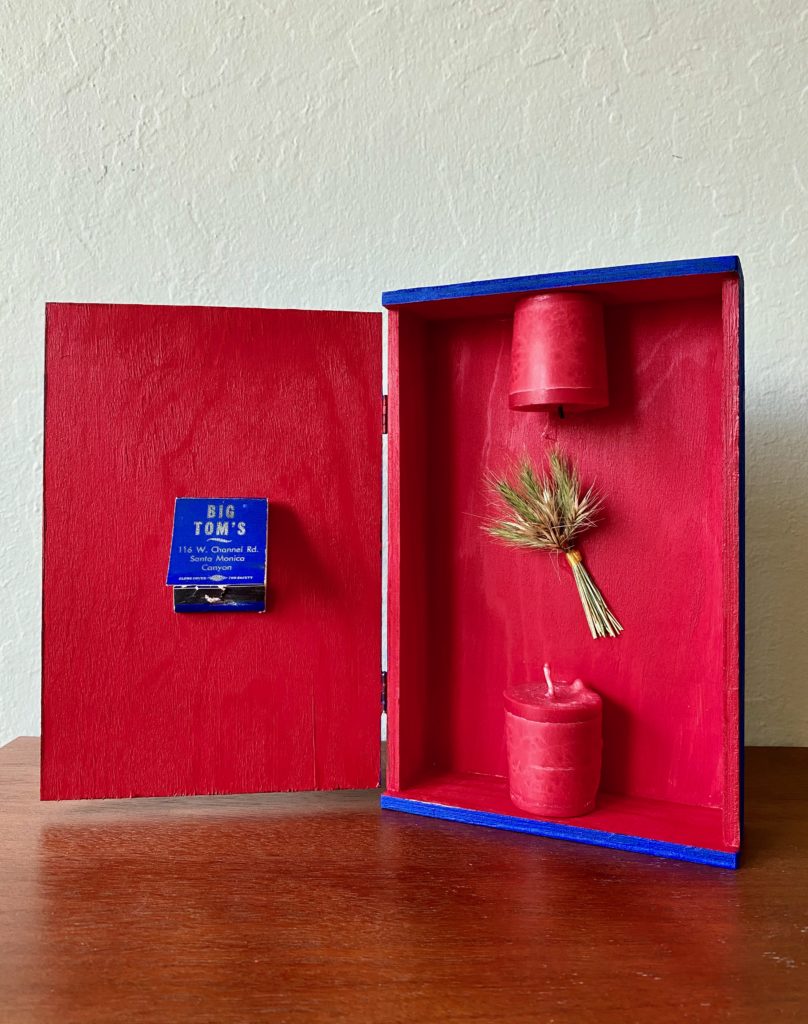
Carpe Diem was realized for MAPP Festival as part of the Red Poppy Art House program. We all have experienced the end of something we cared for —a relationship, a job, a life time in a specific place. Carpe Diem elaborates the grief for an ended experience into a possibility for commemoration and for welcoming what comes next. The title of the work recalls the famous sentence by latin poet Horace, translatable with “catch the present moment”. Being able to catch the present and embracing anything that comes with it allows us to accept the unpleasant life’s events, such as the end of a meaningful experience, with a constructive approach thanks to our lucid grasp on time (that is relative and fleeing). Carpe Diem honors the resilient ability of facing difficult changes.
The visual vocabulary of the shadow box refers to the symbology of the month of August (MAPP was held on August 1-2). I got inspired by the Celtic tradition of Lughnasadh, a holiday held on August the 1st that honors the God of the Sun: Lugh. The wheat represents the Sun —God regulating the growth of plantation. During Lughnasadh they were burning wheat as a celebrative ritual to pay homage to the power of the God and of the wheat plantations themselves, that could feed the whole community. In fact, in Europe the month of August ends the hard seeding season with warm and sunny weather and providing rich harvests. After winter and spring, this is the proper time of the year to rest, to reap the rewards of our sacrifices, and to prepare for the rest of the year ahead of us. Symbolically August is the favorable time for elaborating transitions between ended experiences and new beginnings; this same meaning is also present in the ancient pagan Roman and Greek cultures. The name of the month itself comes from the Roman emperor Ottaviano Augusto, who picked this month amongst the others as a space in time for self-care and for celebrations.
The wheat at the center of the box symbolizes the ended experience, elaborating it as a possibility for a new life phase. The candles facing each other upside down stand for a different way of picturing past, present and future. We usually visualize time in a linear way, but within the transition space between an end and a beginning, past and future can be seen on the same line, mirroring each other and connected by the present —the wheat. The burnt candle at the top expresses the ritualistic act of commemoration, while the intact candle at the bottom expresses the new experience ahead of us. There are only three matches in the matches box used to burn the candle. Three is a powerful number meaning good luck, completeness and connection between past, present, and future.
Instead of looking at the Covid global crises as the end of life as we were used to know it, Carpe Diem encourages to live the present as a possibility to make future life choices differently, and to ricalibrate our values scale.
